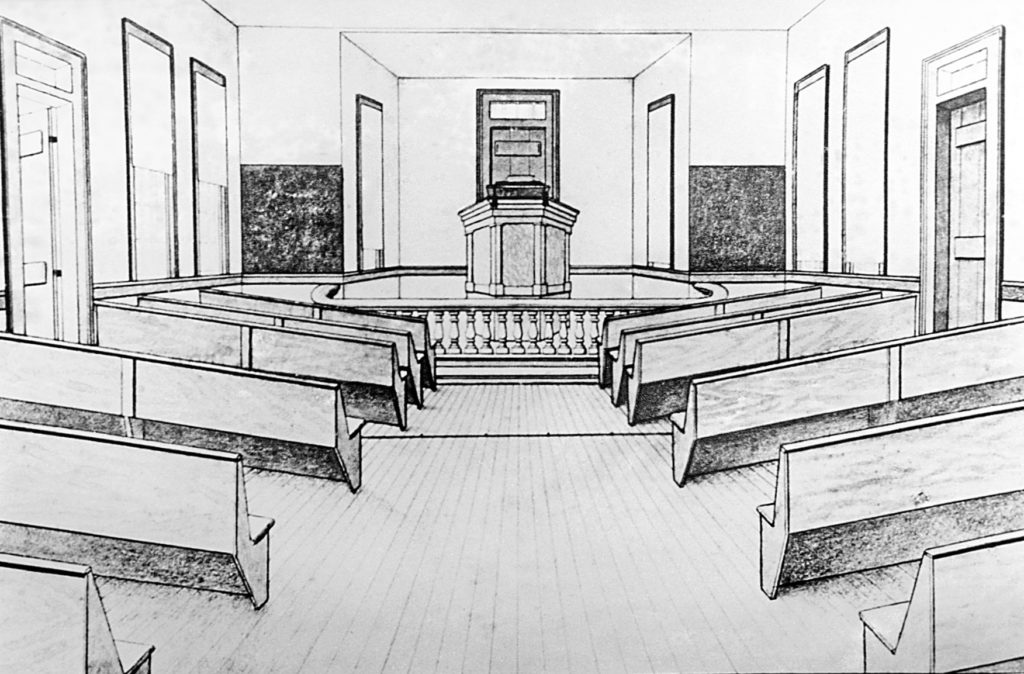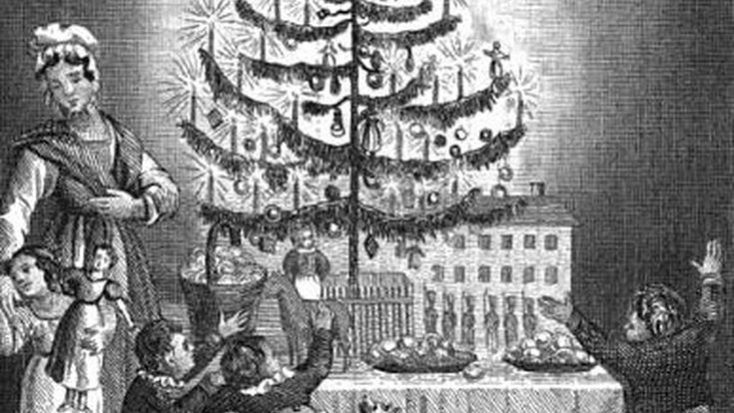“Christmas Eve” sketch from the frontispiece of The Stranger’s Gift by Hermann Bokum, Boston 1836. Library of Congress, Public Domain.
Christmas in the Lowcountry of South Carolina will be celebrated this month, as it has been for centuries. However, back in the antebellum days, the planters celebrated one way and the enslaved much differently. Like the plantation system, which was imported from Britain, the Christmas traditions when the Reverend James Julius Sams (1826 – 1918) reflected on his childhood around 1835 – 1840 on Datha Island were probably more British-inspired than German. It is German immigrants who brought us the Christmas tree. And as the image above attests, Christmas Trees were part of the tradition in some parts of our country. However, the good reverend never mentions a Christmas tree on Datha.
Julius begins his reflections about Christmas this way,
Christmas was the merriest and saddest time. The merriest, because we were all together. The saddest, because the time was coming for us to part again.
As you might expect from any young child, Julius had much to say about Christmas on Datha. I’ve included his Christmas reflections at the end of this article. However, I highlight a few observations about what JJ Sams remembers. I end with two pieces from others about the very different white and black antebellum Christmas experiences.
Syllabub
In one of his passages on Christmas, Julius says,
“The first room of the middle house was called the girls’ room. It was the scene of all the Christmas preparation and completion. Its very atmosphere seemed to savor of jelly, mince pie, cheese, cakes (a perished pastry, I believe), and Syllabub.”
What struck me about this statement is, what the heck is syllabub? The young James Julius Sams loved it. After all, he remembered it 70 years later! My wife, the chef, knows what syllabub is, but not I.
One 18th-century recipe for syllabub reads: “…a quart of thick cream, and half a pint of sack (i.e., white fortified wine), the juice of two Seville oranges or lemons, grate in the peel of two lemons, half a pound of double refined sugar. After whipping the ingredients together, they were poured into glasses. The curdled cream separated and floated to the top of the glass.”
By the 19th century, this traditional British holiday drink often used cider instead of wine.
Gathering
JJ Sams continues,
“The old brick oven was in the yard. We took a great interest in the heating of it, always thinking the cook too slow and rejoicing in the good tidings, hot enough, hot enough. We were very active in carrying the news from the oven to the room. Then such a number of waiters, all full of all kinds of pies would come streaming out of that room down the steps to the oven. We never felt uneasy about the pies. The wonder was where were the people to eat them all. Twenty-seven mouths though as was often the case, soon left shelves empty that had been crowded.”
What struck me here is the mention of “twenty-seven mouths.” We know quite a bit about the family during these years. At first, I thought this number could help us fine-tune the year he is talking about. I analyzed the Sams Family Tree between 1830 and 1840 and counted the members of Berners’ and Lewis’ families for those years. I included any spouses and grandchildren who had come along. Since they each had a plantation on Datha, I assumed they could and maybe would gather either separately or alone at this time of year.
However, since they both had large families, I could not come up with a definitive answer. Berners family by itself did not reach this size, including spouses and grandchildren, until the mid to late 1840s. If both families gathered together for Christmas, the number could have reached 27 in the late 1830s. However, if they met together AND had non-family members over, this number could have been met almost anytime.
I can say with some confidence that JJ’s reflections on his childhood are from when he was about 12 years old, plus or minus five years.
Christmas Sermon in the Chapel
About the Chapel, built in 1833 when JJ was seven years old, he says,
“I ought not to forget the Chapel under the great oak tree that shaded the graveyard. In those days I cannot say that I was especially fond of the Chapel at Christmas. And yet it is Christmas that reminds me of it. My Father had a book of sermons by Burden. There was one on the text, “Let us now go to Bethlehem and see, etc.” and even now whenever I hear that text read, or read it myself, it matters not where I am or about what I am thinking at the time, my thoughts immediately go to the Christmas sermon in that Chapel.”

This trigger, which transports JJ back to Datha Island, is understandable. The Biblical passage he mentions is still read this month in churches all over America. From Luke 2, lines 9-15
“An angel of the Lord appeared to them, and the glory of the Lord shone around them, and they were terrified. But the angel said to them, “Do not be afraid. I bring you good news that will cause great joy for all the people. Today in the town of David a Savior has been born to you; he is the Messiah, the Lord. This will be a sign to you: You will find a baby wrapped in cloths and lying in a manger.
Suddenly a great company of the heavenly host appeared with the angel, praising God and saying, “Glory to God in the highest heaven, and on earth peace to those on whom his favor rests.”
When the angels had left them and gone into heaven, the shepherds said to one another, “Let’s go to Bethlehem and see this thing that has happened, which the Lord has told us about.”
Christmas Tree on Datha?
I’m interested, or maybe disappointed, that Julius makes no mention of a Christmas tree in their Datha customs. Perhaps the tradition, which has German roots, was late to catch on in this decidedly British-influenced South Carolina area. See the sources below for an interesting article about the history of Christmas Trees in America.
Saddest Time of Year
Rev. James Julius Sams ends his comments about Christmas in this way,
“I said that Christmas was not only the merriest but the saddest time. The saddest, because we were about to separate, some to return to their home on one island, some to their home on another, and others to Beaufort. We boys were amongst these last. It was indeed the saddest time for us, because we were about to stop playing before we were tired of play and to go to work before we were ready to work.”
The Wall Street Journal had an article recently about how feeling melancholy is a part of Christmas. Its evidence is the historical events that led to inspiring many of our popular songs and novels. It mentions, for instance,
“In November 1863, during the Civil War, Henry Wadsworth Longfellow’s son Charles was seriously wounded in battle. A few weeks later on Christmas, Longfellow wrote “I Heard the Bells on Christmas Day,” reflecting on how the carnage “mocks” the holiday’s promise of “peace on earth, good-will to men.” In 1943, Bing Crosby’s recording of the song “I’ll Be Home for Christmas” spoke to millions of soldiers and their families who couldn’t celebrate the holiday together: “I’ll be home for Christmas/If only in my dreams.” [Dr. Hansen]
Dr. Hansen summarizes his points elegantly when he says,
The darkness of Christmas is an indispensable part of the holiday, reminding us that while it can never be banished, it can be acknowledged and absorbed into our celebration.
—Dr. Hansen is Master Lecturer of Rhetoric at Boston University’s College of General Studies.
I feel like Rev James Julius Sams would agree.
1905-Christmas-on-Datha-by-JJ-SamsBlack and White Antebellum Christmas Celebrations
To provide a richer context on Christmas traditions on a plantation in the antebellum south, I found two excellent articles on a website dedicated to Gone With the Wind. The site was last updated in 2011, but the content is fascinating, well written, and appropriately sourced. The articles try to make sense out of the movie/book. The authors are rather fascinated with how much is true and fiction in the classic book. Below are their articles White Christmas in the Antebellum South and Black Christmas in the Antebellum South.
Because I don’t know when the site might go away, I’ve converted both articles into PDF documents and included them below. Please read each article in its entirety, not just the first pages you see displayed below. Thank you to How We Do Run On – A Gone with the Wind Scrapbook for these articles.
Sources
Biblia at Faithlife dot com
Bokum, Herman – A Stranger’s Gift, 1836
Dr. Hansen of Boston University, The Darker Side of Christmas, The Wall Street Journal, Dec 19, 2020
How We Do Run On – A Gone With the Wind Scrapbook, White Christmas in the Antebellum South, Black Christmas in the Antebellum South, December 2010
McNamera, Robert – How Christmas Trees Became a Popular Tradition, ThoughtCo dot com, May 2019
Sams, Rev. James Julius – Excerpts about Christmas from his DATHA memoir, circa 1905
Wikipedia – syllabub


